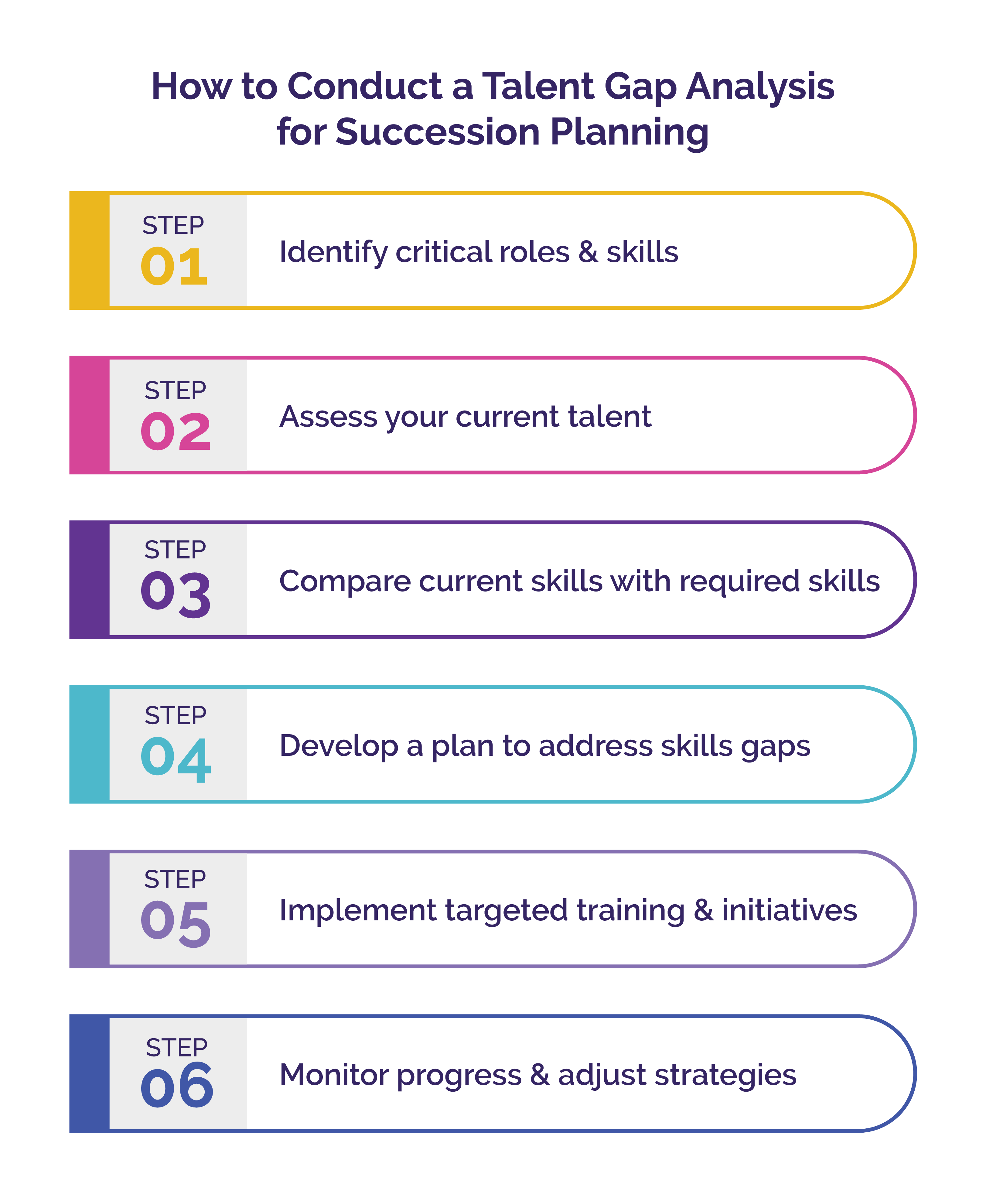Published: Aug 12, 2025Time to read: 5mins Category: Talent Management
6 Steps to Conducting a Talent Gap Analysis for Succession Planning
Table of Contents
Employees will come and go, but strategic planning can help your organization thrive instead of fumble during times of change. With a strong succession plan in place, you can mitigate the challenges that arise when your senior leaders and highly skilled workers eventually move on from your organization.
However, identifying and preparing your future leaders means doing a lot more than establishing which employees have been with your business the longest. You need to have a clear understanding of the skills and capabilities your organization requires to achieve its long-term business goals—and which employees are most likely to acquire them. That’s where a talent gap analysis comes in.
A talent gap analysis compares the skills your organization currently has with the ones it will most likely need in the future. It helps you identify critical gaps, prioritize development areas, and build a talent pipeline that supports your long-term business success.
The following six steps will help you conduct a talent gap analysis that strengthens your succession planning strategy and future-proof your organization.

READ MORE ABOUT SUCCESSION PLANNING | ‘How to Build a Robust Internal Talent Pipeline’
Step 1: Identify Critical Roles and Skills
Start by pinpointing the roles that are essential to your organization’s success. Identify which positions are critical now and the roles that will keep you competitive in the future. The easiest way to do this with your current roles is to determine which vacancies would cause the biggest disruptions to your productivity or performance. When considering your future needs, use your organization’s long-term roadmap and strategic ambitions. Identify your goals for the next three to five years, and assess which skills or competencies you need within your workforce to achieve them.
Whether you’re planning for your current or future workforce needs, it’s crucial to define the key skills, knowledge, and competencies each role will require. Don’t just look at technical expertise—consider leadership, strategic thinking, and soft skills, too.
Step 2: Assess Your Current Talent
Next, evaluate the current talent in your workforce. What skills and experience do your employees have today compared to the skills you’ll need them to have in the future? Tools like performance reviews, skills assessments, and manager feedback will give you valuable insights into your workforce. Gather quantitative and qualitative data so you have a holistic view of your internal talent landscape.
KEEP READING ABOUT PERFORMANCE FEEDBACK | ‘6 Strategies to Boost Your Continuous Feedback Program’
Step 3: Compare Current Skills With Required Skills
Once you’ve gathered data on your internal needs and your current workforce skills, it’s time to analyze the gap. Map your organization’s future workforce needs against your current talent landscape. While it’s possible to do this with spreadsheets, it’s best to leverage a robust talent management platform that can easily identify where your current workforce falls short of your future skills requirements.
During your analysis, be sure to look for:
- Missing leadership competencies
- Underrepresented key technical skills in your talent pool
- Single points of failure where only one person holds key knowledge or capabilities
Step 4: Develop a Plan to Address Skills Gaps
Highlighting gaps will help you prioritize your employee development efforts to ensure you can nurture your future leaders effectively. Your strategy will depend on your unique situation, but it’s likely to include some or all of the following development strategies:
- Leadership mentoring
- Stretch assignments
- Job rotations
- Formal training programs
- Upskilling initiatives
The goal is to equip your high-potential employees with the tools they’ll need to step into critical roles when the time comes.
KEEP READING | ‘What Is Succession Planning? Plus, 5 Tips for Succession Planning Success’
Step 5: Implement Targeted Training and Initiatives
Put your plan into action with focused learning and development efforts. Align your professional training programs with the skills and competencies identified in your gap analysis. Communicate clearly with employees about opportunities for growth—why it matters, how it supports business goals, and how they can take the next step in their career.
Also keep in mind that employee growth doesn’t always mean moving up. Not every employee wants to move into a managerial or leadership role, but most workers still value professional growth and development. That’s why 84% of employees agree with the statement “Learning adds purpose to my work.” Lateral development opportunities can help build depth and flexibility across your teams to prepare your organization to take on future challenges.
Step 6: Monitor Progress and Adjust Strategies
Succession planning isn’t a one-time effort. As your business evolves, so will your talent needs. Prioritize regular talent gap analyses so you can continuously update your data, refine your strategies, and track employee progress. Doing so will ensure your plans stay relevant and aligned with your goals.
Visualize Your Talent Gaps and Prepare for the Future
When used effectively, a talent gap analysis does more than prepare you for future vacancies—it helps you build a stronger, more agile workforce from the inside out.
Discover gaps, identify high-potential talent, and ensure your organization’s future success with help from PeopleFluent Talent Management. Request a demo to see how our software can support your organization today!